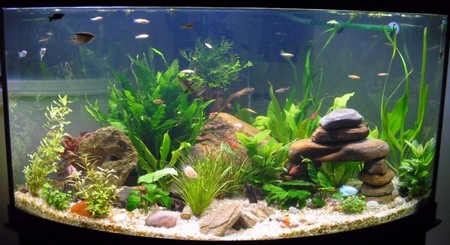If you have followed all the necessary stages, and checked that the equipment is functioning properly, your aquarium should be almost ready to receive fish. A final, vital step is to condition the water to make it suitable for them. This removes harmful chemicals such as chlorine or the more toxic chloramine that are often present in tap water. Find a great Discount Water Filters’ water filters for refrigerator on this site and more information.
The dangers of chlorine and chloramine
Water companies add chlorine to the water supply as a safe disinfectant, but unfortunately, this chemical is toxic to fish, even in minute quantities. Most water supplies have a chlorine level of 0.2 – 0.5mg per litre, but as little as 0.1 mg per litre may be sufficient to harm fish. The good news is that chlorine will naturally diffuse out of solution quite rapidly, especially if the water is aerated: allowing it to stand for about 24 hours after pouring should usually be adequate.
Another agent is sometimes added to the tap water in place of chlorine, which is potentially even more toxic to fish. Called chloramine, this chemical is a combination of chlorine and ammonia, and takes longer to diffuse out of solution. Although a standard dechlorinating agent such as sodium thiosulphate will effectively remove chlorine by binding with it, in the case of chloramine, this action would lead to free ammonia in the water. This is especially dangerous in a new aquarium where the filter bed is not yet fully established. You should therefore use a means of effective chemical filtration as well, to strip out the free ammonia from the water. Zeolite sachets are usually recommended for this purpose.
Check with your water supply company if they are using chlorine or chloramine. Fortunately, some of the newer water conditioners on the market have been developed specifically to overcome the toxic effects of chloramine, rather than chlorine on its own, so make sure you use one of these if necessary.
Effects of chlorine poisoning
The active agent that affects the fish is hypochlorous acid, which is formed from the combination of chlorine and water molecules. Fish exposed to tap water that has not been dechlorinated display obvious signs of distress, swimming around wildly at first, in the hope of avoiding the poison. After this, their colour starts to fade, and they become inactive, often shimmying for a time. Their breathing becomes laboured before they die. Some species, usually those that can breathe atmospheric air directly, are less vulnerable than others. Provided that the cause of their distress is recognized in time, immediately adding a dechlorinator to the water should enable them to recover.
Protective conditioner
Using a water conditioner has an additional benefit: It helps to provide a coating for the fish, reinforcing the natural protective mucus barrier on the surface of their bodies. This natural barrier helps to protect the fish from fungal disease and other infections. It may be accidentally damaged when you catch a fish, so making it more vulnerable to disease. Be especially careful if you ever need to handle a fish directly (which is not recommended), and always wet your hands with the aquarium water first, since the protective mucus is then less likely to come off onto your own skin.
Snails
When deciding which species you want to keep, you might consider compatible creatures other than fish, usually invertebrates such as snails. Make sure that your selected species will live in harmony; some fish, such as boxfish for example, readily eat snails. Apple snails (Ampullaria species) are a popular choice; these are naturally brownish-green, but there is now a striking bright yellow variant available.
The red ramshorn snail (Planorbis corneus) is reddish-brown with a distinctly coiled appearance. They are not entirely vegetarian, so must be excluded from spawning tanks because they will eat the fish eggs.
Feeding snails
Snails browse on algae, helping to keep it in check, but in a new aquarium, where algal growth is minimal, they may well turn their attention to the plants. This can be devastating, especially as the plants are not yet established, so are less able to rejuvenate. It is therefore advisable to add snails only after several months.
Aquatic snails favour certain plants (such as Hygrophila stricta), so choose tough, less appetising plants if you plan to include these molluscs. Snails may also eat left-over particles of fish food, but do not rely on them to scavenge and clean up the tank for you.
Breeding snails
The other major problem with snails is their rapid rate of reproduction, especially in the absence of predators. Snails have both male and female sex organs, so having more than one snail invariably gives rise to fertile eggs. The eggs take about three months to hatch, with the young snails being miniature replicas of their parents. Provide additional sources of green food at this stage, to help prevent the growing snail population from eating the plants. At some stage, you will need to curtail their numbers, and this is best achieved by removing at least some of the eggs before they develop. In an aquarium habitat, snails usually live for a couple of years.

